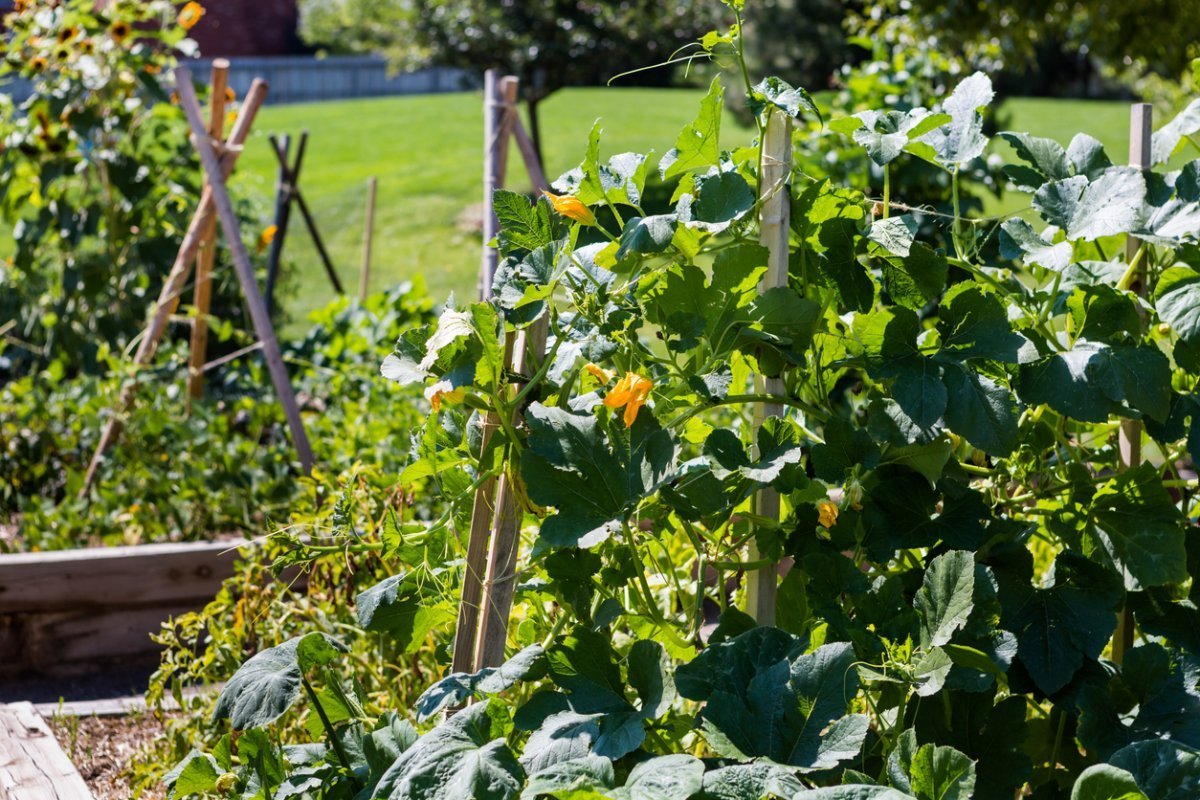It’s usually after the third or fourth big snowstorm that I start sketching out my garden design for the spring. If I’m being extra nerdy, I’ll even bust out the graph paper. My desire to micromanage each square foot of my backyard is outdone only by my desire to save money. This is where recycled materials come in! In garages, basements, and tool sheds across the world, there are gobs of recyclable materials we can use to build a DIY vegetable trellis.
Vegetable trellises are a key part of any vegetable garden and are perfect for climbing vegetables like pole beans and peas, different types of squash, and tomatoes. A DIY vegetable trellis made from recycled materials will help you maximize your garden’s square footage and minimize the impact on your wallet! Here are some ideas on how to create your very own DIY vegetable trellis using recycled materials.
Discover 7 top tips for growing, harvesting, and enjoying tomatoes from your home garden—when you access the FREE guide The Best Way to Grow Tomatoes, right now!
Branches and twine
Using fallen branches and some twine, you can customize a DIY vegetable trellis to fit nearly any space in your garden. The two most common shapes resemble a clothesline and a teepee. The clothesline method requires two sturdy X shapes built from branches, with twine woven between the two structures. You can make another version using branches set in a circle vertically resting against each other at the top, like a teepee. Weave twine around the branches at various heights to create places for vegetables to grow.
Wooden pallets
I don’t like to use wood pallets for constructing planters, because who even knows where they come from or what they’re saturated in. But in terms of structure, wooden pallets make a great DIY vegetable trellis since they are so versatile. You can lean two pallets facing each other like a roof to create a double-sided vegetable trellis. Or screw two together to form a right angle for a four-sided trellis. The easiest (possibly laziest) method is to lean a wooden pallet against a fence or a wall. Your DIY vegetable trellis is ready! In all cases, you may need to add some twine or wire at different height intervals for vegetables to grab onto.
Fencing or chicken wire
Generations of “Keep-That-We-May-Need-It-Someday” folks will no doubt have some old fencing or chicken wire lying around. Following a similar method as the wooden pallets, you can shape your DIY vegetable trellis to fit any space in your garden. Either lean the materials against a wall or fence, or build something freestanding for your climbing vegetables.
Bicycle rims
Okay, this one is a wild choice but I was very impressed when I saw it. If you have two old bicycle rims, you can configure them with a pole connecting them in the center. One rim sits on the ground and the other stands above it, with twine or wire weaving between both sets of spokes. This is a great way to get 360-degree use out of your DIY vegetable trellis. Another way to use bicycle rims is to mount them vertically onto a post or fence. In both versions, the spokes make excellent perches for your climbing vegetables.
Old screen door
The structure of a screen door is perfect for a DIY vegetable trellis since it is sturdy and has a wide opening. In that opening, you can weave twine or wire. You can even attach pieces of wood or bamboo at various intervals to create excellent vertical space for your climbing vegetables.
A wall and some strong ropes
If you have a sturdy wall or fence you can simply attach rope or strong wire both vertically and horizontally, creating a grid. Your climbing vegetables will have plenty of surfaces to reach to. Take care not to use this method too close to other invasive climbing plants like ivy. Those plants can take over and potentially cause damage to your fence or wall in the long run.
The sky’s the limit!
If you’re into creative and unique garden designs, think outside of the box and let your imagination run wild. Nearly anything can be used to create a DIY vegetable trellis. I’ve seen old headboards converted and planted in the ground or even an old metal box spring. The key is to think vertical and provide lots of perches for your vegetables to climb.
Do you have a DIY vegetable trellis? What is it made out of? Share your experiences in the comments!
Discover 7 top tips for growing, harvesting, and enjoying tomatoes from your home garden—when you access the FREE guide The Best Way to Grow Tomatoes, right now!

5 replies on “How to Build a DIY Vegetable Trellis from Recycled Materials”
I wired two short closet shelves together at one end. Stood them on the other end, like an upside down “V”.
I’ve been using the 2 sides of my children’s crib. It was no longer conforming to current safety standards, so couldn’t be used by another child. And it’s a pleasant reminder of my 2 babies as the cucumbers and tomatoes climb upward!
I use an old chain link fence gate and when I need more height as my VINES grow I attach old chicken wire to the top…even so It can get pretty exciting with the rapid growth!
Can you grow pole beans in a hanging basket like you can peas?
Yes! They might climb a bit but mostly they’ll hang, I recommend a higher spot 🙂